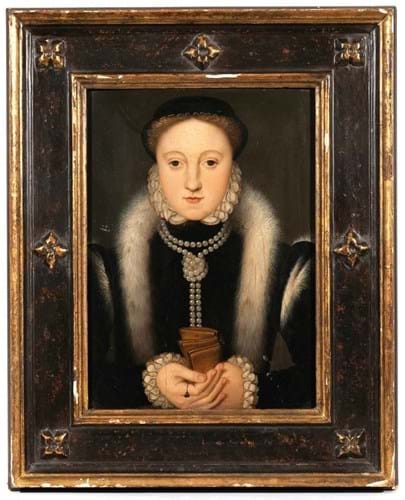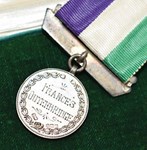
A small but enigmatic oil on panel catalogued as ‘Anglo-Dutch School’ drew a dramatic competition in an upstate New York auction after an eleventh-hour reassessment suggested it may be an early lifetime depiction of Elizabeth I.
However, while it was knocked down over 10-times top estimate to a US collector, a number of leading dealers told ATG they did not bid due to doubts over its date.
The unsigned work came to Butterscotch Auction Gallery from a private vendor in Scarsdale, New York, who was selling a number of paintings inherited from his grandmother in the early 2000s. The 12½ x 9in (32 x 23cm) portrait was one of around 20 works that had been in storage in his home.
According to Butterscotch, the family had always thought that the sitter was Mary, Queen of Scots, rather than her cousin Elizabeth and this was how it was catalogued for the November 21 sale and estimated at $5000-10,000.
The ‘nine-day queen’
Seven days before the auction, however, art historian and blogger Francis Mouton set in play an art historical ‘Twitter storm’ with an online article identifying the work as the so-called ‘Berry-Hill’ portrait of the ‘nine-day queen’ Lady Jane Grey. Its whereabouts had been unknown since it was sold by New York dealership Berry-Hill Galleries in the early 1960s.
An early 20th century owner had been the American banker John Pierpont Morgan (in 1907 it was first identified as Lady Jane Grey), although when later de-accessioned by the New York’s Metropolitan Museum of Art at Parke Bernet in 1956 the sitter was described as ‘unknown’.
As Mouton mentioned in his blog post, the sitter had also since been thought to be Katherine Grey (Jane’s sister) or the Princess Elizabeth c.1555. Sir Roy Strong, former director of the National Portrait Gallery, ambiguously described it as “Princess Elizabeth: perhaps Lady Jane Grey” although personally Mouton deemed the possibility of it being Elizabeth “out of the question”.
However, after plenty more comment, the portrait came to the attention of Dr John Stephan Edwards, a specialist in Elizabethan iconography and images of Lady Jane Grey in particular. He was aware of this work through the Met’s old black and white photographs and had mentioned it in his 2015 book A Queen of a New Invention: Portraits of Lady Jane Grey Dudley.
Not wanting the portrait to escape under the radar and be lost for another 60 years, Edwards contacted the auction house and provided a submission. He included a comparison of the current picture to two seemingly related portraits tentatively identified in the 20th century as depictions of the young Elizabeth: the Chawton portrait in Hever Castle and the Soule portrait in a private collection.
He believed the higher degree of artistic skill and greater visual appeal of the Butterscotch work suggested it may be a prototype of the other two works. His assessment concluded: “The greatest probability is that the sitter depicted is Elizabeth I as she appeared late in the reign of her sister Mary or early in her own reign, before she asserted control over her own iconography in about 1563.”
This led Butterscotch to re-catalogue the work just four days before the auction as ‘English school, 16th century, Portrait of an unknown lady (likely Queen Elizabeth I)’.
So, how did the market react? As ever, with historical portraits, not everyone was wholly convinced. Some potential bidders were less concerned with the name of the sitter than with the date of the painting.
Tudor doubt
Separately, the Old Master portrait specialist Bendor Grosvenor said on his website Art History News that after inspecting high-resolution images of the work he “wondered if it is actually Tudor”.
“Some things puzzled me, like the technique in the hands, the drying cracks in the face, the overly ‘sweet’ characterisation, and the apparent lack of the usual style of gilding you’d expect to see in areas like the collar.”
Another dealer, who did not believe it to be a contemporary portrait from the late 1550s, told ATG they had been offered the work in the late 1980s and declined to buy it.
Nevertheless, some parties had strong belief in the picture or at least were keen to speculate that it might be something special. The auction house reported “several English institutions bidding on the lot, including Hever Castle”, as well as interest from English and European dealers, and a private collector from Belgium.
However, it ended up being knocked down to a local private collector bidding in the room who finally saw off an online underbidder at $120,000 (£92,000) plus 22% buyer’s premium.
The winning bidder, who has now contacted Edwards in the hope of resolving the identity of the sitter, said that they would be happy to show the painting publicly at an appropriate exhibition or museum in due course.
Edwards told ATG that he respectfully disagreed with the doubters and was “very hopeful that we can eventually arrive at a reasonable attribution, even if that attribution is not to one of the ‘leading artists of the day’”.
Scientific tests on the pigments and the panel could help to answer some questions.
Edwards added: “As Dr Grosvenor has already very correctly indicated, dendrochronology is required if we want to be reasonably certain of the date of creation. And I am happy to say that the buyer of the painting seems interested in pursuing that study, so we may be able to reach an objective resolution to that issue in the near future rather than relying on subjective opinion.”














